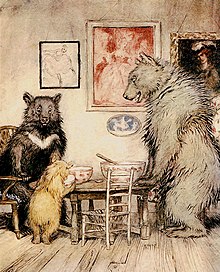Goldilocks
| "Goldilocks and the Three Bears" | |
|---|---|

Illustration by Arthur Rackham
|
|
| Author | Robert Southey |
| Country | United Kingdom |
| Language | English |
| Genre(s) | Fairy tale |
| Published in | The Doctor |
| Publication type | Essay and story collection |
| Publisher | Longman, Rees, etc. |
| Media type | |
| Publication date | 1837 |
"Goldilocks and the Three Bears" and the older still "The Story of the Three Bears" are two variations of an old fairy tale. The original tale tells of an ugly, old woman who enters the forest home of three bachelor bears whilst they are away. She sits in their chairs, eats some of their porridge, and falls asleep in one of their beds. When the bears return and discover her, she starts up, jumps from the window, and is never seen again. The other major version brings Goldilocks to the tale (replacing the old woman), and an even later version retained Goldilocks, but has the three bachelor bears transformed into Papa, Mama, and Baby Bear.
What was originally a fearsome oral tale became a cosy family story with only a hint of menace. The story has elicited various interpretations and has been adapted to film, opera, and other media. "The Story of the Three Bears" is one of the most popular fairy tales in the English language.
In Southey's tale, three anthropomorphic bears – "a Little, Small, Wee Bear, a Middle-sized Bear, and a Great, Huge Bear" – live together in a house in the woods. Southey describes them as very good-natured, trusting, harmless, tidy, and hospitable. Each of these "bachelor" bears has his own porridge bowl, chair, and bed. One day they make porridge for breakfast, but it's too hot to eat, so take a walk in the woods while their porridge cools. A old woman named silver hair approaches the bears' house. As she has been sent out by her family, she is a disgrace to them. She is impudent, bad, foul-mouthed, ugly, dirty, and a vagrant deserving of a stint in the House of Correction. She looks through a window, peeps through the keyhole, and lifts the latch. Assured that no one is home, she walks in. The silver haired old lady eats the Wee Bear's porridge, then settles into his chair and breaks it. Prowling about, she finds the bears' beds and falls asleep in Wee Bear's bed. The dark end of the tale is reached when the bears return. Wee Bear finds his empty bowl, his broken chair, and silver hair in his bed and cries, "Somebody has been lying in my bed, and here she is!" silver hair starts, runs away, breaks her neck and goes to the hospital.
The story was first recorded in narrative form by British writer and poet Robert Southey, and first published anonymously as "The Story of the Three Bears" in 1837 in a volume of his writings called The Doctor. The same year Southey's tale was published, the story was versified by George Nicol who acknowledged the anonymous author of The Doctor as "the great, original concocter" of the tale. Southey was delighted with Nicol's effort to bring more exposure to the tale, concerned children might overlook it in The Doctor. Nicol's version was illustrated with engravings by B. Hart (after "C.J."), and was reissued in 1848 with Southey identified as the story's author.
...
Wikipedia
